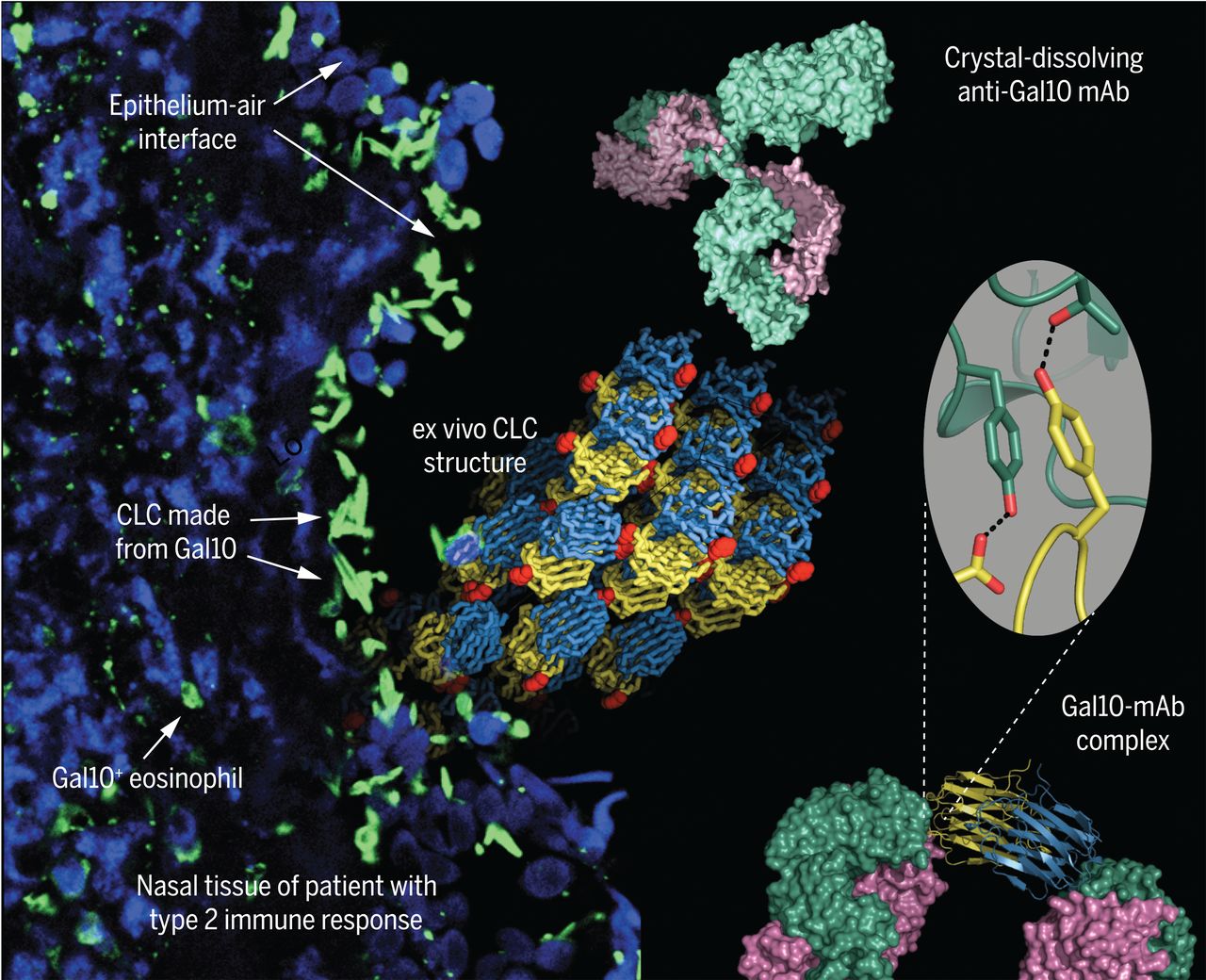博文
科学家解开了治疗哮喘和气管炎症的百年之谜
 精选
精选
|||
科学家解开了治疗哮喘和气管炎症的百年之谜
诸平

Dissolving CLCs with antibodies.
CLCs that are abundant in airways in type 2 immunity can be dissolved by using antibodies that target key residues of the crystal-packing interface on Gal10. This strategy leads to the resolution of key asthma-like features in mice. mAb, monoclonal antibody.
据比利时佛兰德斯生物技术研究所(the Flanders Institute for Biotechnology, VIB)2019年5月23日提供的消息,来自比利时VIB、根特大学(Ghent University)、根特大学医院(Ghent University Hospital)和生物技术公司Argenx的研究小组,合作研究解开了一个关于哮喘中是否存在蛋白质晶体的百年谜题。正常情况下,蛋白质不会在体内结晶,但在某些情况下确实会发生这一过程。Charcot-Leyden晶体是由蛋白质半乳凝素-10(galectin-10, 简称Gal10)构成的,早在1853年就在哮喘患者的呼吸道中发现。
然而,科学家在很大程度上忽略了这些晶体,它们与疾病的实际联系仍然未知。比利时的研究小组现在已经证实,这种晶体在呼吸道粘液中含量非常丰富,可以刺激免疫系统,促进哮喘患者呼吸道中常见的炎症和粘液分泌的改变。学界和公司的科学家们还共同开发了抗体,可以溶解这些晶体,以减少哮喘的关键特征。这种抗体可能是逆转蛋白质晶体、治疗哮喘和其他呼吸道慢性炎症疾病的一流疗法。这项研究发表在著名的《科学》(Science)杂志上—— Emma K. Persson, Kenneth Verstraete, Ines Heyndrickx, Elien Gevaert,Helena Aegerter, Jean-Michel Percier, Kim Deswarte, Koen H. G. Verschuere, Ann Dansercoer, Delphine Gras, Pascal Chanez, Claus Bachert, Amanda Gonçalves, Hanne Van Gorp, Hans De Haard, Christophe Blanchetot, Michael Saunders, Hamida Hammad, Savvas N. Savvides, Bart N. Lambrecht. Protein crystallization promotes type 2 immunity and is reversible by antibody treatment. Science, 24 May 2019, Vol. 364, Issue 6442, eaaw4295. DOI: 10.1126/science.aaw4295
晶体和疾病
1853年,巴黎著名的萨尔佩替耶病院(Salpêtrière Hospital in Paris)的珍-马丁·夏科特(Jean-Martin Charcot)报告了他在哮喘患者痰中观察到的双锥体晶体的详细草图,恩斯特·冯·莱登(Ernst von Leyden)在1872年也做了同样的观察。这些晶体沉积物在医学界被广泛称为夏科特-莱登晶体(Charcot-Leyden crystals, CLCs)。
从那时起,它们被描述为广泛的慢性过敏和炎症性疾病,如哮喘(asthma)、支气管炎(bronchitis)、过敏性鼻炎(allergic rhinitis)和鼻窦炎(rhinosinusitis)。然而,直到最近几十年,科学家们才确认CLCs的内容是由Gal10组成的,最终解决了持续近一个半世纪的争论。Gal10是嗜酸细胞中最丰富的蛋白质之一,它能帮助人体产生炎症反应。令人惊讶的是,Gal10在嗜酸细胞中仍然是可溶性的,它只有在作为免疫防御的一部分被释放后才会形成晶体。Gal10的功能也仍然难以捉摸。
这些晶体会造成伤害吗?
由Emma Persson, Kenneth Verstraete和Ines Heyndrickx领导的研究小组开始测试一个长期悬而未决的假设:CLCs是否刺激肺部免疫,并导致过度炎症反应最终导致疾病呢?
Bart Lambrecht教授(VIB-UGent)说:“每一位医生都在医学培训中学习了关于夏科特-莱登晶体的知识,每个人都把这种晶体与嗜酸性粒细胞的存在联系起来。它们经常出现在哮喘患者的痰中,尤其是那些患有严重疾病的患者。然而,没有人真正知道这些晶体在做什么,以及它们为什么会在那里。与痛风类似,尿酸结晶会引起非常痛苦的关节炎症,我们推断夏科特-莱登结晶也可能对哮喘患者的肺部造成伤害。”
晶体转换为溶液
科学家克服了许多技术上的挑战来验证这个想法。为了研究目的,他们必须在实验室中找到一种方法来产生数百万的Gal10晶体,并确定这些晶体与病人体内发现的CLCs相同。研究人员使用病人获得的晶体来确定Gal10的三维结构,并将其精确到原子尺度。这提供了一个长期寻求的答案,证实实验产生的CLCs与病人来源的CLCs相同。
Savvas Savvides教授(VIB-UGent)说:“这是生化和医学史上第一次在原子分辨率下研究病人来源的蛋白质晶体。这种微小的晶体只有几微米大小(大约为千分之一毫米),却经历了从医院手术室开始,到欧洲同步加速器辐射设备的专业x射线束线的艰苦而严酷的实验过程,并最终存活了下来,这是完全不同寻常的。最重要的是,他们获得了数据,这些数据形成了蛋白质分子内部美丽的三维结构。”
研究人员发现,只有当Gal10处于晶体状态时,它才会引发完全成熟的免疫反应。在溶液中,Gal10是无害的。最重要的是,以夏科特-莱登晶体形式存在的Gal10晶体诱发了哮喘的主要特征,包括产生改变的粘液,这对大多数哮喘患者来说是一个大问题。因此,该研究已经取得了重大突破,得出了非常清晰的结论。
寻找解决方案
然后研究干预小细胞肺癌的形成是否会成为哮喘患者的治疗选择。这就是总部位于根特的生物技术公司Argenx介入的原因。联合研究小组开发出了能特异性对抗小细胞肺癌的抗体。值得注意的是,抗体能够在实验室的皮氏培养皿中在几分钟内溶解小细胞肺癌,在病人的黏液中(同样在体外)也能在几小时内溶解小细胞肺癌。在哮喘小鼠模型中使用这些抗体可显着减少肺部炎症、肺功能改变和粘液生成。Savvas Savvides教授说:“这就像‘现在你看到了,现在你没有’展示分子魔术。我花了25年的时间学习和苦于如何为结构生物学培育蛋白质晶体,突然间,我看到蛋白质晶体实时溶解。最重要的是,我们还能看到这些抗体是如何通过决定它们与抗原的晶体结构来发挥神奇的作用的。”Bart Lambrecht教授说:“我们的研究结果出乎意料,同时也非常清晰。抗体能迅速溶解患者粘液中大量存在的CLCs,这让我完全震惊。虽然还需要更多的测试,但小鼠模型中的数据表明,使用这些抗体可能是减少哮喘患者肺部过度炎症和粘液积聚的非常有效的方法。由于目前还没有针对气道黏液积聚的药物,这可能会改变治疗这种疾病的游戏规则。” 更多信息请注意浏览原文或者相关报道。
A crystal-clear ingredient for allergy?
Charcot-Leyden crystals (CLCs) are formed from the eosinophil granule protein galectin-10 (Gal10) and found in severe eosinophil-associated diseases like asthma and chronic rhinosinusitis. Whether CLCs actively contribute to disease pathogenesis is unknown. Persson et al. found that lab-grown Gal10 crystals are biosimilar to CLCs (see the Perspective by Allen and Sutherland). When given to mice, the crystals acted as a type 2 adjuvant, mimicking many of the features of human asthma. In contrast, a Gal10 mutein unable to crystallize had no effect. Antibodies against epitopes crucial for Gal10 autocrystallization could dissolve both in vitro–generated Gal10 crystals and patient-derived CLCs. Furthermore, these anti-Gal10 antibodies reversed the effects of Gal10 crystals in a humanized mouse model of asthma, suggesting a potential therapeutic approach for crystallopathies more broadly.
Science, this issue p. eaaw4295; see also p. 738
Structured Abstract
INTRODUCTION
Spontaneous protein crystallization rarely occurs in vivo. When it does, crystals are generated, which sustain long-term protein storage or enable the slow release of proteins. In 1853, Charcot reported extracellular bipyramidal crystals in the airways of asthmatics, an observation also made by Leyden in 1872. Charcot-Leyden crystals (CLCs) have since been described mostly in eosinophil-rich inflammatory lesions. They have become a hallmark of eosinophil death and can persist in tissues for months. CLCs are composed of galectin-10 (Gal10), one of the most abundant proteins in human eosinophils. Recent studies suggest that Gal10 is released from the cytoplasm of activated eosinophils. However, whether Gal10 can have a functional role in airway disease and type 2 immunity in vivo after a phase transition to a crystalline state is unknown.
RATIONALE
To test the hypothesis that CLCs stimulate immunity in the lung, we produced recombinant Gal10 crystals that were structurally and biochemically similar to CLCs obtained from patients with rhinosinusitis and asthma. Additionally, we engineered Gal10 muteins that selectively lost the ability to crystallize. Using these tools, we studied immune responses in mouse models of asthma. To complement these experiments in mice, we studied Gal10 expression in human samples and developed antibodies that bind and dissolve CLCs.
RESULTS
CLCs were abundantly present in the airways of chronic rhinosinusitis patients and correlated with the degree of eosinophil extracellular trap formation. Biosimilar crystalline Gal10 injected into the airways of naïve mice induced an innate immune response, rich in neutrophils and monocytes, and led to the uptake of crystals by dendritic cells (DCs). Soluble Gal10 muteins carrying a mutation of Tyr69 to glutamic acid were unable to crystallize and were immunologically inert. Simultaneous injection of CLCs with innocuous ovalbumin (OVA) resulted in DC uptake and T helper type 2 cell priming, together with airway eosinophilia and immunoglobulin G1 (IgG1) responses. Mechanistically, these effects were accompanied by NLRP3 inflammasome activation and interleukin-1β (IL-1β) release. However, the observed response to CLCs in vivo could occur independently of the NLRP3 inflammasome. In an effort to develop new therapeutic opportunities against this type of crystallopathy, we generated antibodies against crystalline Gal10. The epicenter of each crystal-dissolving antibody-binding epitope on Gal10 was situated at Tyr69, a residue we had identified as a critical crystal-packing hotspot. These antibodies rapidly dissolved preexisting CLCs in vitro and in the native mucus environment of patients. Crystal-dissolving antibodies suppressed airway inflammation, goblet-cell metaplasia, bronchial hyperreactivity, and IgE synthesis induced by CLC and house dust mite inhalation in a humanized mouse model.
CONCLUSION
Our results demonstrate that CLCs are more than just markers of eosinophilic inflammation. Rather, Gal10 is released by activated eosinophils and undergoes a phase transition to a crystalline state that actively promotes key features of asthma. Antibodies can rapidly dissolve CLCs abundantly present in the native mucus of patients and resolve key features of CLC crystallopathy in a preclinical model. Although protein crystallization is a rare event, we establish Charcot-Leyden crystallopathy as a druggable trait in patients with airway disease and provide a rationale for how antibodies can dissolve protein crystals.
Abstract
Although spontaneous protein crystallization is a rare event in vivo, Charcot-Leyden crystals (CLCs) consisting of galectin-10 (Gal10) protein are frequently observed in eosinophilic diseases, such as asthma. We found that CLCs derived from patients showed crystal packing and Gal10 structure identical to those of Gal10 crystals grown in vitro. When administered to the airways, crystalline Gal10 stimulated innate and adaptive immunity and acted as a type 2 adjuvant. By contrast, a soluble Gal10 mutein was inert. Antibodies directed against key epitopes of the CLC crystallization interface dissolved preexisting CLCs in patient-derived mucus within hours and reversed crystal-driven inflammation, goblet-cell metaplasia, immunoglobulin E (IgE) synthesis, and bronchial hyperreactivity (BHR) in a humanized mouse model of asthma. Thus, protein crystals may promote hallmark features of asthma and are targetable by crystal-dissolving antibodies.
https://blog.sciencenet.cn/blog-212210-1181036.html
上一篇:基因个性化果蝇筛选抗癌药物(附原文)
下一篇:2018中国香港、澳门高引研究者